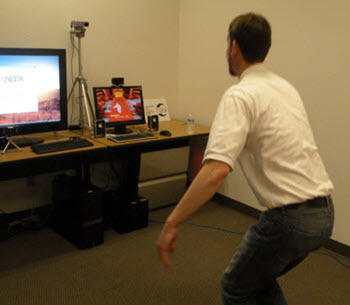
Microsoft is expected to announce it has agreed to buy Canesta, a maker of chips that allow game systems and other electronic devices to recognize gesture controls, the New York Times reported. The purchase price was not disclosed.
[aditude-amp id="flyingcarpet" targeting='{"env":"staging","page_type":"article","post_id":223809,"post_type":"story","post_chan":"none","tags":null,"ai":false,"category":"none","all_categories":"business,games,","session":"A"}']Canesta’s technology is very similar to that used in Kinect, Microsoft’s motion-control system for the Xbox 360. Debuting on Nov. 4, Kinect lets you use your body and gestures to control games. It uses technology that Microsoft acquired in its purchase of 3DV Systems as well as technology that Microsoft licensed from GestureTek and PrimeSense.
If Microsoft is in fact acquiring Canesta, it may be close to having access to all of the major patented technology in the emerging field of gesture recognition, where a device can detect any movement in a given three-dimensional space such as a living room.
AI Weekly
The must-read newsletter for AI and Big Data industry written by Khari Johnson, Kyle Wiggers, and Seth Colaner.
Included with VentureBeat Insider and VentureBeat VIP memberships.
Canesta’s chips are essentially 3D image sensors. The image sensors in the camera, made of ordinary CMOS (complementary metal oxide semiconductor) chips, can detect objects based on light reflections. A light-emitting diode (LED) flashes and the infrared light bounces off the objects and then returns within fractions of a second to the sensor, which measures the travel time for the returning light to gauge distance. The infrared is invisible to the human eye. It works in ordinary light and the user can still operate the controls from across a room.
Canesta’s technology goes beyond controlling games. It can also be used to control TVs, computers, cars, toys and other electronic devices. Microsoft and Canesta declined to comment to the New York Times.
If rivals want to buy the same kind of technology that Microsoft uses in Kinect, it will now be harder to do so. Microsoft is making a big investment in gesture control recognition. In that respect, Microsoft’s bet on gesture controls is as big as the one Apple has made on touchscreens for its phones and mobile devices. Steve Ballmer, chief executive of Microsoft, told the New York Times last week that the company plans to push gesture technology beyond the Xbox 360.
Canesta has raised more than $74 million. Canesta’s investors include Quanta, a Taiwanese company that makes laptops for many of the major brands, Venrock, Carlyle Group, and Honda. The company was started in 1999 and has collected more than 40 patents.
VentureBeat's mission is to be a digital town square for technical decision-makers to gain knowledge about transformative enterprise technology and transact. Learn More
